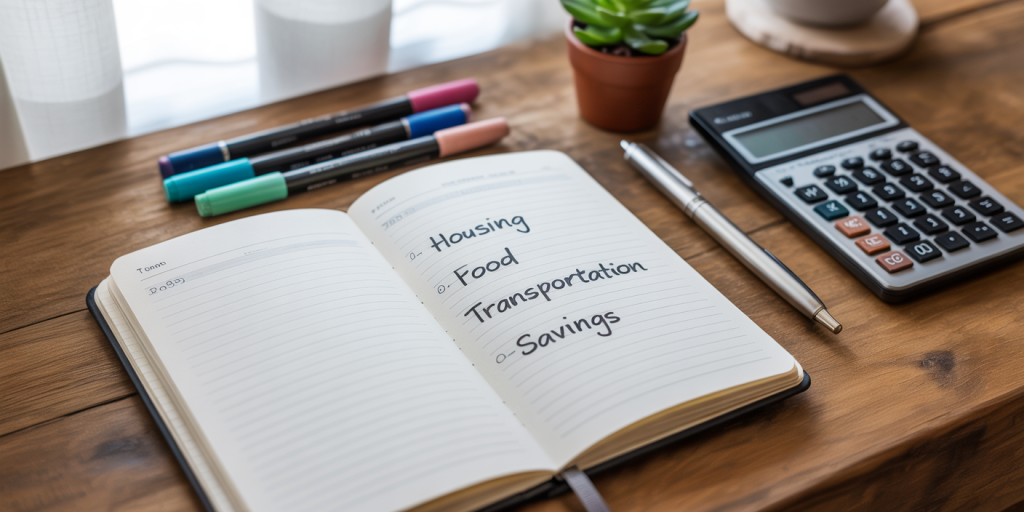How to Create a Realistic Budget You’ll Actually Stick To
Introduction: Why Most Budgets Don’t Work
Let’s face it: budgeting has a bad reputation. For many people, the word “budget” conjures up feelings of restriction, deprivation, and stress. But a well-crafted budget isn’t a punishment — it’s a plan for freedom, clarity, and control. The reason most people fail at budgeting isn’t because they lack discipline; it’s because the budget they create doesn’t reflect their real life.
In this guide, you’ll learn how to build a realistic, flexible, and personalized budget that you’ll actually be motivated to follow. No complex spreadsheets. No guilt-trips. Just smart, practical steps that work.
1. Start With Your “Why”
Before diving into numbers, get clear on your purpose. Why do you want to budget?

- To stop living paycheck to paycheck?
- To pay off debt?
- To save for a house or a dream vacation?
- To reduce money stress?
Knowing your “why” gives you motivation and direction, making it easier to stay committed, even when the process gets challenging.
2. Track Your Spending for One Full Month
Don’t guess where your money is going — track it. For at least 30 days, write down every dollar you spend. Use apps like:
- Mint
- YNAB (You Need A Budget)
- PocketGuard
- Spreadsheets or notebooks
Categorize your spending into essentials (like rent, groceries, and bills) and non-essentials (like eating out, shopping, and subscriptions).
This step creates financial self-awareness, which is the foundation of any successful budget.
3. Know Your Monthly Income
Calculate your net income — the amount you take home after taxes and deductions. If your income fluctuates, use the average from the past three months, or base your budget on your lowest monthly earnings to stay safe.
Sources of income may include:
- Salary or wages
- Freelance/contract work
- Side gigs
- Government assistance
- Dividends or passive income
Your budget should only be built on what you actually receive — not on expected or irregular income.
4. Choose the Right Budgeting Method for Your Lifestyle
Not every budget works for every personality. Choose a method that fits your habits and goals:
a) Zero-Based Budgeting
Every dollar has a job. Your income minus your expenses equals zero. Perfect for people who like structure and accountability.
b) 50/30/20 Rule
A simpler approach:
- 50% Needs
- 30% Wants
- 20% Savings/Debt Repayment
This method is ideal for beginners or people with regular income.
c) Envelope System
Allocate cash (or digital categories) into spending envelopes. When the envelope is empty, spending in that category stops. Great for visual thinkers or people who overspend easily.
5. Categorize Your Expenses
Group your expenses into three main categories:

Essentials:
- Rent/mortgage
- Utilities
- Groceries
- Transportation
- Insurance
- Minimum debt payments
Financial Goals:
- Emergency fund
- Retirement contributions
- Savings for big goals
- Extra debt payments
Discretionary Spending:
- Dining out
- Entertainment
- Shopping
- Subscriptions
- Travel
Use real data from your spending tracker to assign realistic amounts to each.
6. Plan for Irregular and Annual Expenses
A common mistake is forgetting expenses that don’t occur monthly, such as:
- Car repairs
- Gifts and holidays
- Medical expenses
- Annual insurance premiums
- School supplies or tuition
Create a “sinking fund” — a monthly savings category for these occasional expenses. For example, if your car insurance is $600 per year, save $50 per month.
7. Set Specific, Achievable Goals
Budgeting without a goal is like sailing without a compass. Define short- and long-term goals:
- Save $1,000 in 6 months for emergencies
- Pay off $3,000 in credit card debt within a year
- Contribute $200/month to a retirement account
Use the SMART goal framework:
Specific, Measurable, Achievable, Relevant, Time-bound.
8. Automate What You Can
Automation helps eliminate forgetfulness and removes temptation. Set up:
- Automatic transfers to savings on payday
- Auto-payments for fixed bills
- Recurring investments into retirement or brokerage accounts
What’s out of sight is often out of mind — and that’s a good thing when it comes to saving and paying down debt.
9. Review and Adjust Weekly
Check in with your budget every week — not just once a month. Weekly reviews let you:
- Spot overspending early
- Reallocate funds between categories
- Adjust for upcoming expenses
A short 15-minute check-in is all it takes to avoid nasty surprises and stay on course.
10. Make Room for Fun
A budget with zero fun is a budget destined to fail. Add a “fun money” category for guilt-free spending — whether it’s $20 or $200, depending on your income.
When you give yourself permission to enjoy some of your money, you’re less likely to rebel and blow the whole budget out of frustration.
11. Build an Emergency Fund
Unexpected expenses will happen. Start with a goal of $500 to $1,000, then work toward 3 to 6 months’ worth of living expenses.
Your emergency fund should be:
- In a separate savings account
- Easy to access, but not too easy
- Used only for true emergencies (not vacations or sales!)
12. Use Visual Tools to Stay Motivated
Progress is powerful. Use tools like:
- Debt payoff trackers
- Savings thermometers
- Budgeting dashboards
- Color-coded spreadsheets
Visuals help you see the impact of your decisions and stay inspired to keep going.
13. Involve Your Partner or Family
If you share expenses with someone, you need to budget together. Discuss goals, review the budget regularly, and split responsibilities.
Create a system where both partners have a say and a stake in your shared financial success. Use shared budgeting apps like Goodbudget or Zeta for couples.
14. Don’t Aim for Perfection — Aim for Progress
No one sticks to a budget perfectly every month — and that’s okay. Budgeting is a skill, not a test.
You’ll overspend sometimes. You’ll forget something. The key is to learn, adjust, and keep going.
Celebrate small wins:
✅ Paid off a credit card?
✅ Saved for your first emergency fund?
✅ Tracked your spending for 30 days?
Each success builds momentum.
15. Budgeting Is a Lifestyle, Not a One-Time Task
The goal is to make budgeting part of your routine — just like brushing your teeth or going to the gym. Make it sustainable:

- Pick one day a week to check in
- Set a calendar reminder each month to review goals
- Adjust your budget as your life changes
A great budget evolves with you — through promotions, setbacks, kids, or relocations.
Final Thoughts
Creating a budget that you’ll actually stick to isn’t about being perfect — it’s about being intentional. When you build a budget that reflects your real income, values, and lifestyle, you won’t dread checking it. In fact, you’ll feel empowered every time you do.
Start small. Keep it simple. Focus on consistency, not complexity.
Before long, you’ll discover that your budget isn’t a restriction — it’s your freedom plan.
